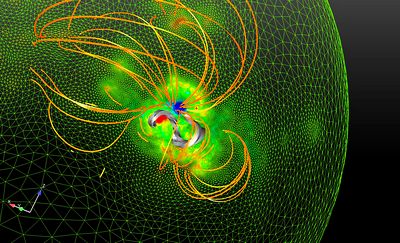|
The sun is home to the largest explosions in the solar system. For example, it regularly produces huge eruptions known as coronal mass ejections – when billions of tons of solar material erupt off the sun, spewing into space and racing toward the very edges of the solar system. Scientists know that these ejections, called CMEs, are caused by magnetic energy building up on the sun, which suddenly releases. But the details of what causes the build up and triggers the release are not precisely understood.
A journal paper in Nature magazine on Oct. 23, 2014, used data from NASA missions to present an example of how something called a magnetic flux rope builds up over time until it is so unstable that even the slightest perturbation will send it flying. Understanding what triggers CMEs is crucial not only for better understanding of our sun, but also to lay the groundwork for predicting when such giant explosions might happen.
"We looked at a well-studied CME from 2006," said Tahar Amari first author on the Nature paper at Ecole Polytechnique in France. "We knew that there had been a great deal of data available for this CME and much analysis already done, but no one had created a comprehensive picture of what happened."
Amari and his colleagues used a traditional meteorology technique to examine the event: Gather observations from the days before the CME to track how the event grew over time. They used observations from the European Space Agency and NASA's Solar and Heliospheric Observatory, or SOHO, and the Japanese Aerospace Exploration Agency and NASA's Hinode, as well as from the Paris-Meudon Observatory .

Scientists created this model to examine the magnetic field before a giant solar eruption – a coronal mass ejection – which occurred on Dec. 13, 2006. The orange lines show magnetic field lines. The grey line represents what's called a flux rope, which built up the day before the event
For a little more insight into the project see this:http://www.nasa.gov/content/goddard/soho-and-hinode-offer-insight-into-solar-eruptions/ | 
